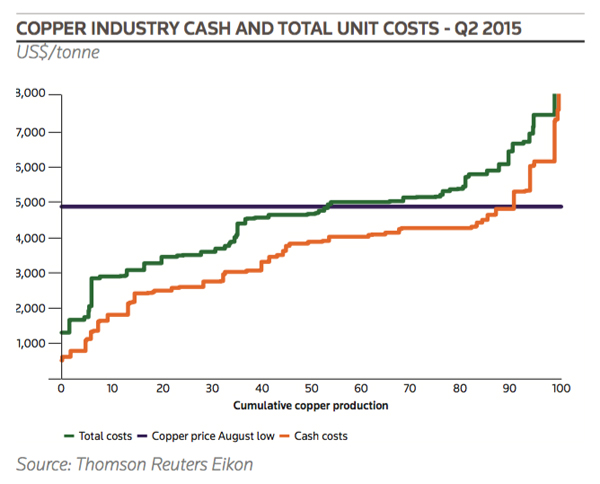Base Metals Aluminium, Copper, Lead, Nickel, Zinc. Bullion Gold, Silver. Energy Crude Oil, NG. Forex USD, INR, Euro, Yuan. Economic Data Reports. LME, COMEX, NYMEX, MCX, Shanghai Markets.
Sunday, October 11, 2015
Saturday, October 10, 2015
How Glencore production cut will affect Zinc?
LME zinc surged by about 2% to climb above $1,700 per ton, and the most actively-trade zinc contract on the SHFE also rose to around 14,000 yuan per ton after Glencore’s cut news.
Glencore said on Friday it will cut 500,000 tons, around one third of its annual zinc output, of global zinc production due to low prices.
How Glencore’s cut news will affect zinc market?
“Zinc prices, in the short term, will get a boost from the cut news, but its weak fundamentals will not allow a sustainable price rise,” an analyst from Guosen Futures told SMM in the latest interview.
Poor zinc consumption in China, due to a slowing economic growth, is the leading reason behind sluggish zinc prices, the analyst pointed out.
“Weak demand is now in marked contrast to high utilization rates at domestic zinc smelters facing high TCs, especially when a traditionally peak demand season in October also fails to materialize so far this year,” the analyst explained.
The global zinc market is also not in good shape, despite no big rise or even a slight drop in LME zinc inventories, as unreported zinc inventories are estimated to be huge.
Glencore said on Friday it will cut 500,000 tons, around one third of its annual zinc output, of global zinc production due to low prices.
How Glencore’s cut news will affect zinc market?
“Zinc prices, in the short term, will get a boost from the cut news, but its weak fundamentals will not allow a sustainable price rise,” an analyst from Guosen Futures told SMM in the latest interview.
Poor zinc consumption in China, due to a slowing economic growth, is the leading reason behind sluggish zinc prices, the analyst pointed out.
“Weak demand is now in marked contrast to high utilization rates at domestic zinc smelters facing high TCs, especially when a traditionally peak demand season in October also fails to materialize so far this year,” the analyst explained.
The global zinc market is also not in good shape, despite no big rise or even a slight drop in LME zinc inventories, as unreported zinc inventories are estimated to be huge.
Over 500 jobs lost as Glencore suspends zinc operations in Australia
Glencore will temporarily suspend operations at Lady Loretta and reduce production at George Fisher and McArthur River operations, the company announced on Friday.
ABC News reports that 242 workers will lose their jobs at Lady Loretta Mine while while 224 positions will be lost from George Fisher, and 69 at the McArthur mine.
The closures gave zinc a bump. The Wall Street Journal says zinc rose 6.7% on the London Metal Exchange today.
Before the news, zinc had dwindled to a five year low, dropping to 72 cents USD/lb late last month. The metal had a 52-week high of $1.09 USD/lb.
Glencore plans to reduce annual zinc metal mine production across its operations in Australia, South America and Kazakhstan by approximately 500,000 tonnes or one-third. There was no news on how operations outside of Australia would be impacted.
"Glencore remains positive about the medium and long term outlook for zinc, lead and silver, however we are taking a proactive approach to manage our production in response to current prices," said the company in a statement.
The company said it has invested over $1 billion across our zinc operations, and it will continue to fund several large scale projects at our operations.
The company regrets the closures.
"These changes, although temporary, will unfortunately affect employees at our operations. This decision has not been taken lightly. In the coming days we will engage with all employees and put in place support services to assist our people who may be affected as a result of these changes."
Lady Loretta—a zinc (sedimentary exhalative) deposit, with additional occurrences of copper, lead, and silver—is located in Australia about 140km NNW of Mt Isa. The mine is an underground operation, employing long-hole stoping technology.
Friday, October 9, 2015
Copper mining's deepening costs crisis
GFMS Thomson Reuter's closely watched annual base metals review and outlook contains some stark warnings for copper miners.
The industry has made progress to reduce costs – since the first quarter of 2014 average cash costs have dropped by $303 a tonne according to GFMS calculations.
Over the same period the price of copper is down by $998 a tonne. And since the end of the June quarter of 2015 (the scope of the report) copper is down another $1,000.
It seems unlikely that the pace of cost reduction can improve much from the relatively modest pace of the last few quarters
GFMS says at the August low of $4,888 a tonne (a six-year low visited again at the end of last month) 10% of the industry is losing money on a cash basis.
But consider total costs (a better proxy for sustaining production levels at mines) and 47% of the industry is unprofitable at a 2009 copper price.
But consider total costs (a better proxy for sustaining production levels at mines) and 47% of the industry is unprofitable at a 2009 copper price.
While costs have been reduced by 8% since the start of 2014, in Q2 2015 cash costs for the industry actually creeped up fractionally over the first quarter.
The inability of copper miners to make deeper cutbacks was despite a 50% fall in the price of crude oil and a sharp depreciation of producer country currencies against the dollar (on average more than 15% says GFMS) over the period. The usual culprit when it comes to rising costs in copper mining – falling grades – were relatively stable.
And the outlook is not all that rosy for the cost curve to lower much more:
"While cash costs may benefit from the lag in the transmission of lower energy prices, it seems unlikely that the pace of cost reduction can improve much from the relatively modest pace of the last few quarters.
"If copper prices continue to languish, additional cuts in sustaining capital are likely in the coming months, which will clearly impact the future production profile. We expect noise levels to increase in the coming months as the industry announces cuts to mine production and capital budgets, but how much of that translates into mine closures and/or a meaningful reduction in volumes remains to be seen."
Monday, October 5, 2015
Why India Might Finally Begin To Get Its Commodities Game Together
India is a commodity powerhouse. It is the largest producer or consumer for commodities that range from milk, pulses and spices to gold, edible oils and industrial crops. It is second largest producer of sugar, rice and cotton. And yet, instead of dictating terms, we follow the prices set overseas for them. What stops us from taking our rightful place in the global order? The feebleness of our market.
The power of any market comes from its ability to set the benchmark price that acts as the reference for all other trades around the globe, whether it is London for physical gold or New York for cotton. India's commodity markets have been illiquid, ill-equipped and ill-connected ever since their inception in 2003 due to a combination of outdated laws and ill-informed policymakers.
Now, 12 years later, this is set to change. SEBI has taken over as the new regulator and guardian of the commodity market, which will now be governed by the Securities Contracts (Regulation) Act, 1956, applicable to stock exchanges. India's commodity markets have a fighting chance to emerge from the shadows.
Here are five steps SEBI can take to make it happen.
1. Create policy stability
Commodity exchanges need a conducive ground created by surrounding institutions such as the government, the banking framework and corporate law. Commodity trading has been frequently disrupted by bans and mid-air changes in trading rules. This destroys market confidence despite a strong regulator. As an independent regulator, SEBI should seek a commitment from Central and state governments to adopt transparent and predictable rules for direct interventions, such as changes in trade policies, procurement operations and trading rules. To prevent panicky reactions, it has to rapidly educate the media, politicians, bureaucrats and the public about the role and mechanics of commodity exchanges.
"SEBI has a historic opportunity to create a wide and enduring economic moat around our commodity markets through sophistication and scale."
2.Consolidate volumes by expanding the network
Size begets power. Commodity exchanges benefit from strong "network effects". These mean that more members are better--the more trades exchanges handle, the more liquidity they can provide and the more activity they attract. By connecting hedgers, government companies such as FCI, and farmer bodies, to generate trade volumes that are in multiples of crop production, SEBI can improve price discovery and make the market more efficient.
3. Build scale by allowing better quality of investors and speculators
A large market to which producers, dealers, manufacturers, and speculators converge makes a contract as liquid as a stock certificate or a coupon bond. Allowing banks, mutual funds and large foreign investors to enter the commodity market will improve its risk-insuring function.
4. Connect to overseas markets
Today, no market is an island. In a hyper-connected world, India will only gain if its commodity contracts are listed on overseas exchanges reciprocally so that they are quickly accepted as a reference price.
5. Create a cost advantage
Compared to overseas markets, it is expensive to trade in India. The commodities transaction tax, local state taxes, high brokerage fees and high cost of physical delivery due to poor logistics have made costs a deterrent. SEBI will have to scrutinise each one so that market participants are attracted by favourable terms and remain loyal due to the high cost of switching business away from India.
In 2014-15, 10 out of the top 20 agricultural contracts by volume were traded on exchanges based in China, according to data from the US's Futures Industry Association. CME's Chicago Board of Trade was the leading agricultural futures market outside China. Precious metals are dominated by the Comex gold and silver contracts traded at CME's New York Mercantile Exchange. The Shanghai Futures Exchange is emerging as an important centre for gold and silver trading in Asia.
India has a natural competitive advantage in a wide swathe of this global commodity market. But it remains untapped because little attention has been paid on how to fight competition. SEBI has a historic opportunity to create a wide and enduring economic moat around our commodity markets through sophistication and scale. If it is successful, India--with its 52 million farmers and 1.2 billion consumers--can finally stand up to take its rightful place in the world of food and natural resources.
SOURCED FROM :- Huffingtonpost.in
Govt reviewing capital mkt reform measures
A recent report on capital markets by a government appointed panel is being examined by the finance ministry and financial regulators, and some its suggestions could perhaps be incorporated in the upcoming 2016-17 Budget.
The report, by the standing council on international competitiveness of the Indian financial sector, was made public in early September and recommended a number of steps to reform derivatives markets for commodity, equity and currency.
Some of these recommendations include removal of securities transaction tax and stamp duties, especially for futures and options products, clarifying tax treatment in exchange-traded currency derivative markets and avoiding ban on any market segment, participant or product.
The report also suggests allowing access to all foreign participants as long as they meet financial Action task force requirements, clarifying regulatory positions on participatory notes, removing regulatory constraints on banks and mutual funds to participate in commodity futures, uniform KYC norms, internationalising the rupee, and a longer term move to a residence based taxation regime.
Senior government sources said that the finance ministry has asked all financial regulators to suggest which of the numerous suggestions, divided into short-term, medium-term, and long-term timelines, can be implemented. Once the government is in agreement with the likes of Reserve Bank of India and Securities and Exchange Board of India on which reforms can be implemented, these could be included in the Budget, they added.
"The various financial regulators have been asked to review these recommendations and suggest which can be implemented, and some of these cannot be carried out, then why not," said a senior official.
Saturday, October 3, 2015
Number crunching: The impact of China's currency devaluation
In mid-August, China shocked markets by devaluing the yuan.
Today's infographic looks at the impact this had on global currencies using three different time frames:
1 day, 1 week, and 1 month.

1 day, 1 week, and 1 month.

In the grand scheme of things, China’s mid-August currency devaluation spree was a drop in the bucket. Since the Financial Crisis, countries have routinely printed money, kept rates pegged artificially low, and found other ways to get temporary competitive advantages with cheaper currency.
While the People’s Bank of China has made some questionable interventions, China’s currency itself has been pegged to the US dollar officially or unofficially since its early history. With the US dollar climbing wildly against most global currencies since mid-2014, the yuan climbed along with it. China’s currency appreciated against all other major Asian currencies, which erased the country’s manufacturing cost advantage and trade surplus. In retrospect, it is almost surprising that they kept the reference rate where it was for this long.
The strong reaction from markets and media was more from the angle that even slightest movement made by China can create a ripple effect on fragile global markets. China, for a better lack of an analogy, is a bull in a china shop. Its economy and currency are seen as important bellwethers and when the PBOC makes an announcement, people listen.
That’s why in mid-summer, markets got volatile in a hurry. China devalued its currency by 1.9% on August 11 and made some smaller changes since then. The country also announced adjustments to how it would calculate its onshore reference rate moving forward.
Today’s infographic looks at the reaction in currency markets in three timeframes after the event: 24 hours, one week, and one month after.
Some currencies, like the euro, appreciated against the Chinese Renminbi right away and maintained that momentum. The euro went up 2.06% in the first day, and then continued to appreciate to 5.73% by the end of 30 days. Others swung back and forth wildly: at first the South African rand was up 0.71%, but then it ended as the biggest loser against the yuan at -4.24% over the course of a month.
Despite the mixed reaction from different currency markets, the reason China did this was clear. The country wanted to promote convergence in its onshore and offshore rates, and it has also been trying to woo the IMF for some time to be included in the IMF’s basket of reserve currencies called Special Drawing Rights. The latter move is a part of China’s posturing to eventually better internationalize the yuan.
As a side benefit of the devaluation, China also gets temporary relief in promoting exports at a cheaper price – though this will only last until the next country takes action in the game of currency war hot potato.
Original graphic by: Inovance
Subscribe to:
Posts (Atom)





